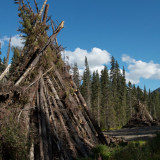
Read this story from CBC on the slashing and burning of thousands of trees by BC Hydro for the construction of its Northwest Transmission Line north of Terrace. (Nov. 7, 2012)
BC Hydro is warning people living northwestern B.C. of smoke haze in that area as they cut down and burn hundreds of kilometres of timber to make way for the Northwest Transmission Line.
The utility’s transmission line project connects an existing substation near Terrace, B.C. and a new substation to be built further north, near Bob Quinn Lake, in 2014.
“In clearing the right of way there’s a lot of woody debris that has to be disposed of. And we do have approval… to dispose of that by burning,” said BC Hydro spokesperson Lesley Wood.
Wood said she didn’t know the total volume of the wood being burned, only that it is considerable.
“When you considering that you’re clearing a right of way up to 80 meters worth of clearing for 340 kilometers — it’s a lot,” she said.
Wood says it isn’t economically viable to use the trees for biofuel or firewood, but says the Nisga’a nation, one of the groups contracted to do the cut and burn, may try to sell some of the timber.
Cariboo North MLA Bob Simpson says the clearing is likely one of the biggest timber cuts in B.C. in 2012.
“This order of magnitude of slash and burn is certainly going to increase B.C.’s contribution to greenhouse gas emissions. When is this province going to get involved in bioenergy, biodigesting in a bigger way so we never have these circumstances?” said Simpson.
“It’s a misuse of a public resource.”
Sharon Glover, the CEO of B.C. Professional Foresters, said there’s no need to be burning the timber — that some of it is bound to be salvageable.
“To say that the forest , ‘We’ll just burn it because it’s not our problem, it’s in our way,’ we need to think differently. If you just burn it you’re saying that timber has no use to anyone. And we just don’t buy it.
“We suspect in the mix of that timber that some of it is going to be merchantable, usable as saw logs, and other timber might be used for bioenergy, shipped to pellet plants or shipped to biomass projects.”

